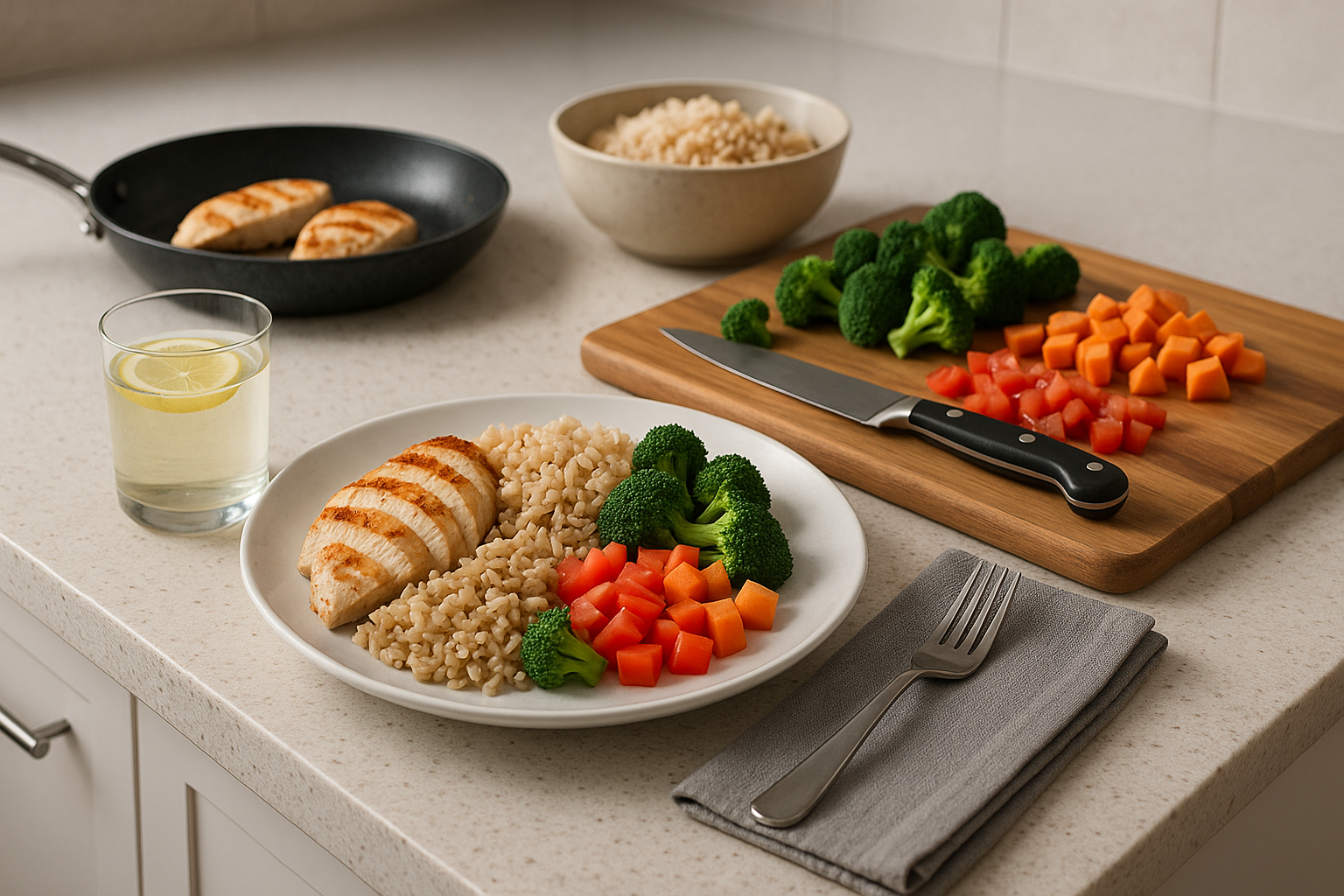Traveling, working remotely, or simply maintaining a busy schedule can often mean that taking the time to prepare a nutritious meal falls by the wayside. However, feeding our bodies well is not just about keeping hunger at bay. It’s about fueling our energy, nurturing our health, and ultimately, optimizing our performance, both physically and mentally.
In our modern, fast-paced world, the need for quick, nutritious meals is not just a luxury, but a necessity. It’s about convenience meeting health, and flavor intersecting with time efficiency. Enter: “Quick Bites for Busy Nomads: 10-Minute Dinners to Keep You Fueled on the Go!” — an article designed to provide the busy nomad with a repertoire of nutritious, easy-to-make, and delicious meals that can be prepared in just 10 minutes.
So, why is this subject so crucial? From the perspective of a software engineer, consider the human body as a sophisticated machine. Just as high-quality code ensures the optimal performance of a program, the right nutrition guarantees the effective functioning of our bodies. And just as software developers need a comprehensive set of tools and strategies to write efficient code, busy individuals need a variety of quick and healthy recipes to stay fueled and functioning at their best.
Unpacking the Menu
This article will serve as your guide, offering a selection of 10-minute dinner recipes, each one designed with busy nomads in mind. These are meals that don’t compromise on nutrition or taste, yet are simple enough to be prepared in a hotel room, a hostel kitchen, or even at a campsite.
But this is not just a recipe guide. In addition to providing detailed instructions for each meal, we’ll delve into the science behind the selected ingredients. We’ll explore why these meals are good for you, how they can boost your energy levels, and what specific nutrients they provide. Moreover, we’ll offer modifications and alternatives for dietary restrictions and preferences, ensuring that everyone can benefit from these recipes.
By the end of this article, you’ll not only have a variety of quick, nutritious meals at your disposal, but also a deeper understanding of how to fuel your body effectively. The goal here is to empower you, the busy nomad, to take control of your nutrition, regardless of how hectic your lifestyle may be.
The Bigger Picture
Furthermore, this guide is part of a bigger conversation about the role of nutrition in our overall health and wellbeing. It’s about recognizing that what we eat influences our energy levels, our cognitive abilities, our physical performance, and even our mood. By choosing to invest a small amount of time in preparing these quick, nutritious meals, you’re making an investment in your overall health and productivity.
So, whether you’re a digital nomad working remotely, a globe-trotting adventurer, or a busy professional with little time to spare, these recipes are designed for you. They are here to make your life easier, healthier, and tastier, one 10-minute meal at a time.
So, get ready to dive in, discover new flavors, and give your body the fuel it deserves, even on the go. Stay tuned for a gastronomic adventure that will transform the way you approach quick meals, proving that nutritious, flavorful food can indeed be created in just ten minutes. Welcome to the world of ‘Quick Bites for Busy Nomads’!
Introduction: The Need for Quick and Nutritious Dinners
As a busy nomad, juggling work, travel, and self-care can often seem like an uphill battle. One of the biggest challenges is maintaining a nutritious diet, especially when dinner time rolls around. After a long day, the last thing you want to do is spend hours in the kitchen. So, how do you ensure a healthy, energy-boosting meal without spending a lot of time cooking? The answer lies in 10-minute dinners. These quick meals will keep you fueled on the go, providing the nutrients your body needs to perform optimally.
Moreover, cooking these meals doesn’t require you to be a culinary wizard. All you need is a handful of ingredients, a bit of planning, and ten minutes of your time. Before we dive into these quick dinner recipes, let’s understand why it’s crucial to pay attention to what you eat, particularly when you’re constantly on the move.
Your body is like a machine, and the food you consume is its fuel. Consuming nutrient-rich meals can help boost your energy levels, improve your immune system, and enhance your overall health. Furthermore, these meals can also help prevent common nomadic ailments like traveler’s diarrhea and jet lag. Now, let’s explore some 10-minute dinner recipes that can keep you fueled on your adventures.
1. Chicken Stir-fry: A Protein-packed Quick Dinner
Chicken stir-fry is a quick, nutritious, and protein-packed dinner that can be cooked in just 10 minutes. It’s a versatile dish that can be customized based on your preferences and what ingredients you have on hand.
Recipe: Heat a bit of oil in a pan and add diced chicken breast. Add your favorite vegetables like bell peppers, broccoli, and carrots, and stir-fry until the chicken is cooked through. Add some soy sauce or teriyaki sauce for flavor and serve it over cooked rice or noodles. Watch this video for a detailed step-by-step guide: “10-Minute Chicken Stir-fry Recipe” by Food Wishes.
This meal is high in protein, which is essential for muscle repair and growth. Additionally, the vegetables provide a range of vitamins and minerals that boost your immune system and enhance your health.
2. Veggie Wrap: A Vegan-friendly Quick Dinner
For those who prefer plant-based meals, a veggie wrap is a quick, nutritious dinner option. It’s easy to make, packed with fiber, and perfect for a meal on the go.
Recipe: Spread hummus or your favorite sauce on a whole grain tortilla. Add a variety of vegetables like lettuce, tomatoes, cucumbers, and bell peppers. You can also add some protein like tofu or beans. Roll up the tortilla, and your veggie wrap is ready to eat. Here’s a video that shows how to make a quick veggie wrap: “Vegan Veggie Wrap Recipe” by The Happy Pear.
This meal is high in fiber, which aids in digestion and helps you feel full for longer. Plus, it’s loaded with vitamins and minerals that can enhance your health and well-being.
Quick Dinner Comparison: Chicken Stir-fry vs Veggie Wrap
| Chicken Stir-fry | Veggie Wrap | |
|---|---|---|
| Time to prepare | 10 minutes | 10 minutes |
| Protein source | Chicken | Tofu or beans |
| Vegetables | Bell peppers, broccoli, carrots | Lettuce, tomatoes, cucumbers, bell peppers |
| Sauce | Soy sauce or teriyaki sauce | Hummus or other vegan-friendly sauce |
| Base | Rice or noodles | Whole grain tortilla |
As you can see from the comparison table, both meals are quick to prepare and offer a good balance of protein, vegetables, and carbs. However, the choice between the two would depend on your dietary preferences and health goals.
Remember, the key to maintaining a healthy diet on the go is planning ahead and choosing meals that are easy to prepare and packed with nutrients. So, try out these quick dinner recipes and keep yourself fueled for your nomadic adventures.

Conclusion
Conclusion
To wrap up this discourse, we have examined several significant aspects of Software Engineering and technical writing. We have covered complex topics like the fundamentals of software development, the principles of software engineering, and the importance of technical writing in the IT and Engineering sectors.
We first delved into the core concepts of software engineering, including software development methodologies such as Agile, Waterfall, and DevOps. We highlighted the necessity of choosing the right development methodology based on the project’s nature, team composition, and business requirements.
The importance of software design and architecture was another major area that we explored. We discussed various design patterns and architectural styles, stressing the significance of a well-planned and robust architecture in developing scalable, efficient, and maintainable software systems.
Next, we emphasized the critical role that testing plays in the software development lifecycle. We tackled different types of testing, including unit testing, integration testing, and system testing, and we underscored the importance of testing at every stage of the software development process to ensure the software’s quality and reliability.
Finally, we discussed the crucial role of technical writing in IT and Engineering, particularly in software engineering. We highlighted the importance of creating clear, concise, and accurate documentation that can help users understand and use the software effectively.
The synthesis of software engineering and technical writing is an important topic that demands attention. The ability to translate complex technical concepts into understandable terms is vital to the success of any software development project. It aids in clear communication among team members and helps users understand the software’s functionality.
We hope that this article has been informative and valuable to you. We invite you to share your thoughts and insights on this topic. Perhaps you have had experiences where good technical writing has made a significant difference in a software project, or maybe you have questions about some of the topics we have covered. We encourage you to leave comments, share this article with others, and apply what you have learned in your own work.
Please feel free to explore further using the ResearchGate and IEEE Computer Society resources. These platforms provide numerous research papers, articles, and discussions related to software engineering and technical writing.
Remember, the field of software engineering is ever-evolving, and keeping abreast of current practices and trends is essential to staying relevant. Continuous learning, combined with effective technical writing, can make a significant impact on the successful completion of a software project.
Sources:
ResearchGate – Software Engineering Principles and Practice
IEEE Computer Society – Technical Writing



